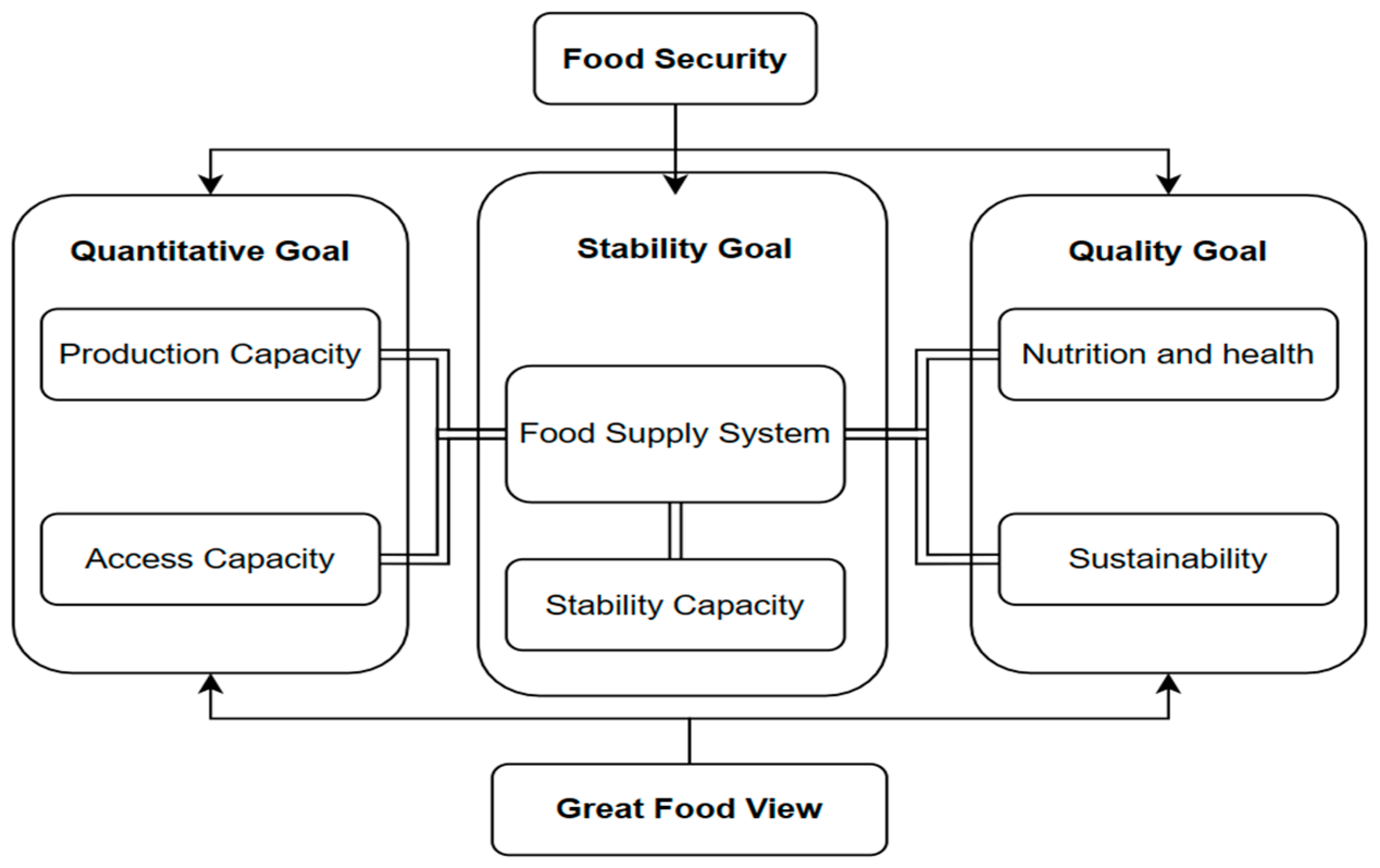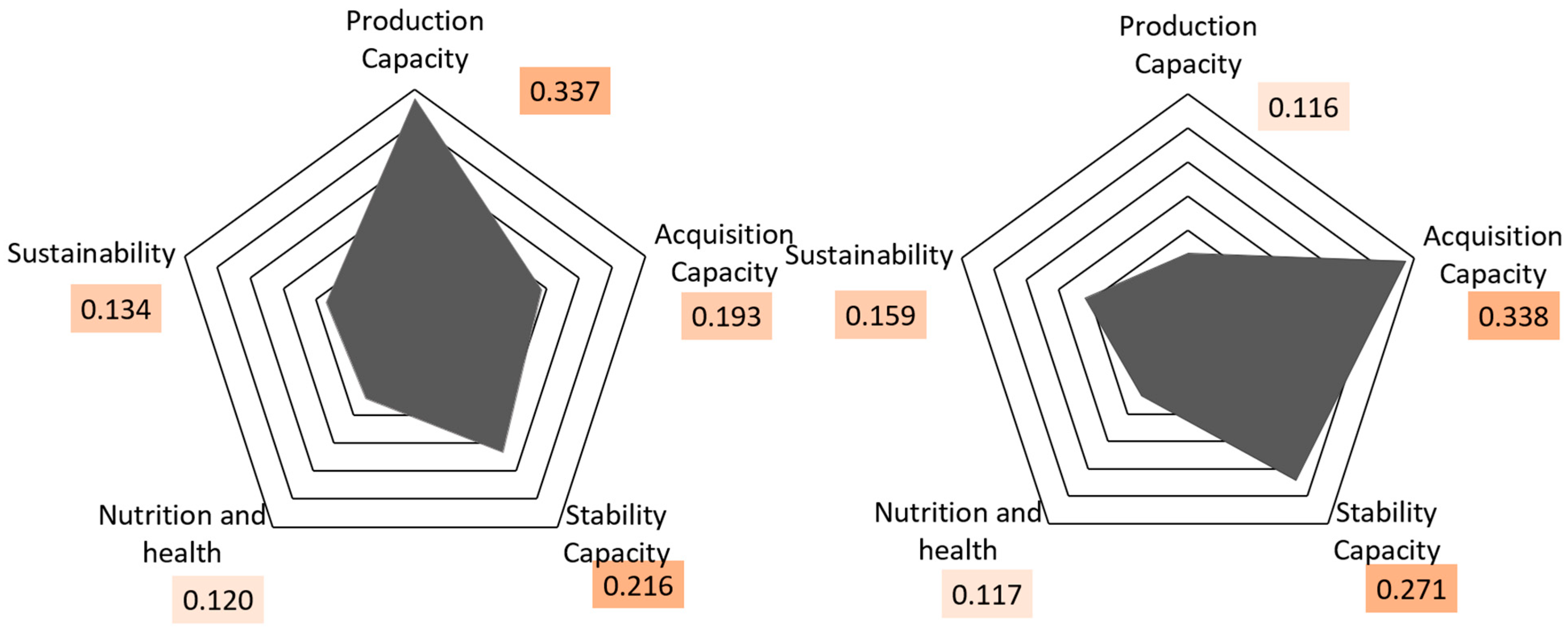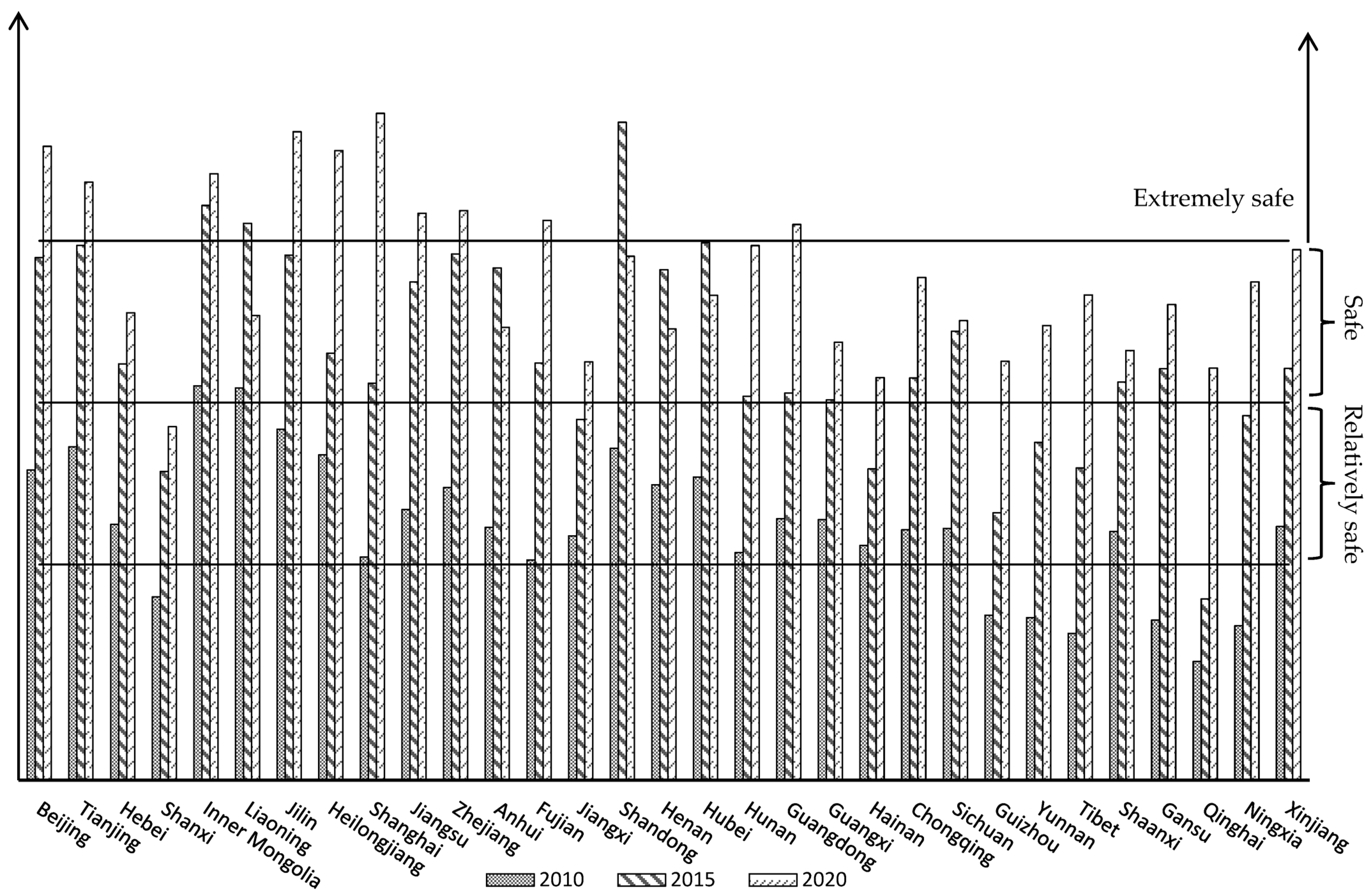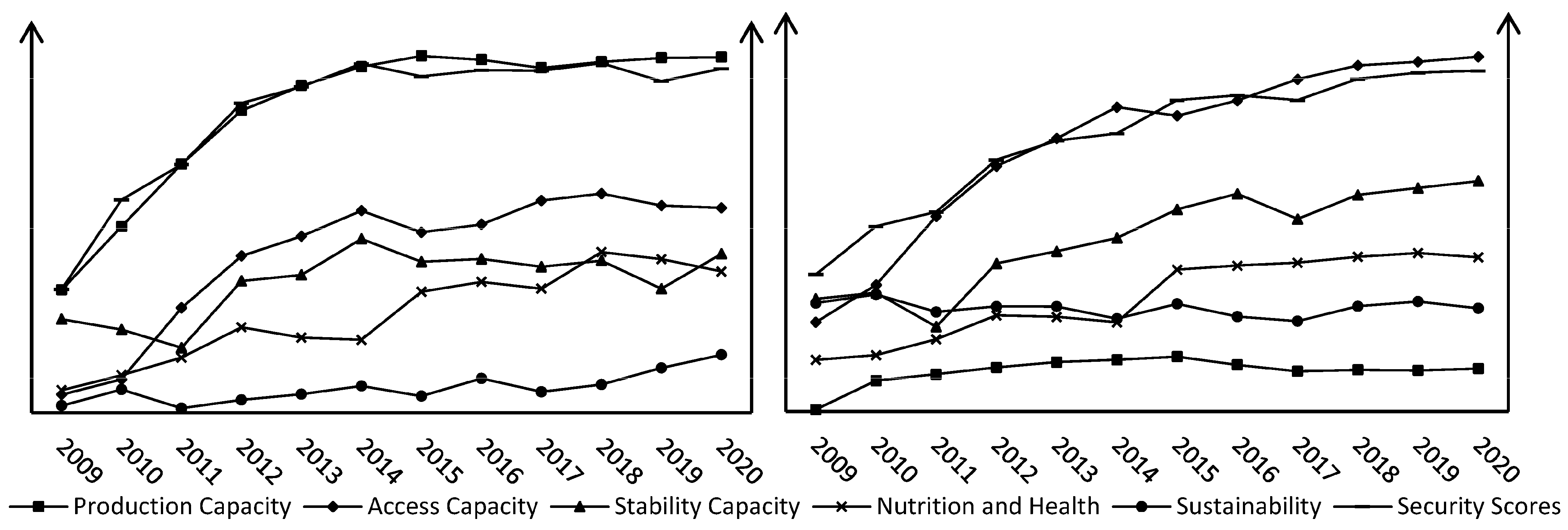Research on the Construction of China’s Provincial Food Security Evaluation System and Regional Performance—Based on the “Great Food View”
Abstract
1. Introduction
2. Literature Review
2.1. Food Security and “Great Food View”
2.1.1. Authoritative Definition of Food Security
2.1.2. Introduction of “Great Food View”
2.1.3. The Relationship between Food Security and “Great Food View”
2.2. Review of Food Security Evaluation Research
2.2.1. Single Index Evaluation
2.2.2. Household Survey
2.2.3. Multi-Index Evaluation
2.3. Literature Review
3. Theoretical Analysis and Construction of Evaluation System
3.1. Principles, Ideas, and Framework
3.2. Index System Composition and Index Selection
3.2.1. Meeting the Quantitative Goal Is the Quantitative Requirement for the Food Supply System
Production Capacity (I1)
Acquisition Capacity (I2)
3.2.2. Meeting the Stability Goal Is the Stability Requirement for the Food Supply System
Stability Capacity (I3)
3.2.3. Meeting the Quality Goal Is the Quality Requirement for the Food Supply System
Nutrition and Health (I4)
Sustainability (I5)
4. Data and Methods
4.1. Research Method Selection
4.1.1. Analytical Hierarchy Process
4.1.2. Improved Entropy Weight Method
4.1.3. Index Safety Score Conversion Method
4.2. Data Sources and Index Calculation
5. Food Security Evaluation
5.1. Differences in Food Security Structure between Main and Non-Main Food Production Areas
5.2. Provincial Food Security Evaluation
5.3. Regional Food Security Performance
5.3.1. Performance of Food Security in Main and Non-Main Food Production Areas under the “Great Food View”
5.3.2. Distribution Evolution of Food Security Level in Main and Non-Main Food Production Areas Based on Kernel Density Estimation
- From the distribution position: The center axis of the Kernel density curve indicated the regional average performance. From Figure 5, we can see that the center axis of the Kernel density curve of food security in the main production areas and non-main production areas is both moving to the right, which proves that the overall level of food security in the main production areas and non-main production areas is increasing year by year, which is consistent with the previous conclusions.
- From the distribution pattern: The sharper and higher peak of the Kernel density curve for food security indicates that the distribution of food security performance in the region is more concentrated, and the gap between them is smaller. The wider of Kernel density curve peak is, the more unconcentrated and bigger it is. In terms of distribution pattern, the Kernel density curve of food security in main and non-main food production areas is quite different. The distribution pattern of the Kernel density curve of food security in the main production areas shows the evolution characteristics from “thin peak” to “wide peak” and then to “thin peak”, and the peak value first decreases and then increases, indicating that before 2017. From 2010 to 2017, although the overall food security in the main production areas was continuously improving, the internal differences in the performances of food security were also increasing, high food security provinces and low food security provinces coexist, and the gap is growing. However, after 2017, this phenomenon improved, which is reflected in the “thin peak” and high peak of the Kernel density curve in the main production areas. In non-main production areas, the distribution pattern of the Kernel density curve of food security shows the evolution characteristics from “thin peak” to “wide peak” and then to “more wider peak”, and the peak value is constantly decreasing, which indicates that although the overall food security score of non-main production areas is constantly rising, it is unbalanced. For example, in 2021, the food security score range of provinces in non-main production areas will increase by 41.21% compared with that in 2010, and the standard deviation will increase by 54.50%. The gap within the region will continue to increase in the number of peaks.
- From the number of peaks: In 2021, there is an obvious main peak and a side peak in the main food production areas, but the height of the side peak is lower than the main peak, indicating that the food security in the main production areas will begin to show a “Gradient effect”, and there will be a small group with high food security performance. The “Gradient effect” is more obvious in non-main food production areas. There are main peaks and side peaks in each Kernel density curve in 2010, 2013, 2017, and 2021, which further verifies the unbalanced development of food security in non-main production areas.
- Finally, in terms of distribution extension: The Kernel density curve of the main production areas in 2017 has a significant right tailing, which indicates that there are both high food security provinces and low food security provinces in the main production areas, which also validates the previous conclusions, but the tailing has significantly reduced in 2021, and the development balance has significantly improved. However, the right tailing in non-main food production areas has become “thicker” and longer year by year, indicating that there are not only high food security provinces and low food security provinces, but also the growth rate of provinces with low food security scores is lower than that of provinces with high scores, leading to further widening the gap between high and low provinces.
- To sum up, the overall score of food security in both main and non-main food production areas is increasing from 2010–2021, but the development of food security in provinces within main production areas is more balanced than that in non-main production areas. The distribution shape, peak number, and distribution extensibility of the Kernel density curve all indicate that the “Matthew effect” of food security begins to appear in non-main production areas.
6. Discussion, Conclusions, and Enlightenment
6.1. Conclusions
6.2. Discussion
6.3. Enlightenment
6.4. Limitations and Further Areas
Author Contributions
Funding
Institutional Review Board Statement
Data Availability Statement
Conflicts of Interest
References
- Global Food Economy and Policy Research Institute of China Agricultural University; China Rural Development Research Institute of Zhejiang University; International Food and Agricultural Economy Research Center of Nanjing Agricultural University. Report on China and Global Food Policy Beijing. Chin. Agric. Devel. Forum. 2021, 01, 5–12. [Google Scholar]
- Li, X.D.; Sun, Z.L.; Zhao, Y.H. Global Food Security and Its Governance: Development Process, Realistic Challenges and Transformation Strategies. Chin. Rural. Econ. 2022, 06, 2–22. [Google Scholar]
- Zhu, J. Establish the Concept of Big Food and Build a Diversified Food Supply System. Agric. Econ. Manag. 2022, 06, 11–14. [Google Scholar]
- Fan, S. The Big Food Concept Leads the Transformation of the Agricultural and Food System, and Comprehensively Tamps the Foundation of Food Security. Chin. Rural. Econ. 2022, 12, 14–19. [Google Scholar]
- FAO. The State of Food Security in The World 2012: Economic Growth is Necessary But Not Sufficient to Accelerate Reduction of Hunger and Malnutrition; FAO: Rome, Italy, 2012; Volume 6. [Google Scholar]
- Chen, S.C.; Wang, Q. Analysis of China’s Food Security Concept. Econ. Sys. Reform. 2009, 01, 27–39. [Google Scholar]
- Zhu, Z. Assessment of China’s Food Security. Econ. Res. Ref. 1997, 67, 12–23. [Google Scholar]
- Ke, B.S. China’s Grain Self-Sufficiency Rate and Grain Trade Issues. Agri. Outl. 2007, 04, 3–6. [Google Scholar]
- Lan, H.T.; Wang, W.N. Some Major Issues and Countermeasures of China’s Medium and Long term Food Security. Macro Res. 2007, 06, 7–13. [Google Scholar]
- Jiang, C.Y.; Li, X.G.; Dong, H. Reflections on China’s Food Security and Food Policy—Based on the self-sufficiency rate of grain and the relevant experience of Japan and South Korea. Macro Res. 2014, 03, 3–10. [Google Scholar]
- Maxwell, D.; Vaitla, B.; Coates, J. How Do Indicators of Household Food Insecurity Measure Up? An Empirical Comparison From Ethiopia. Food Policy 2014, 47, 107–116. [Google Scholar] [CrossRef]
- Lo, Y.T.; Chang, Y.H.; Lee, M.S.Y.; Wahlqvist, M.L. Dietary Diversity and Food Expenditure as Indicators of Food Security in Older Taiwanese. Appetite 2012, 58, 180–187. [Google Scholar] [CrossRef]
- Wiesmann, D.; Bassett, L.; Benson, T.; Hoddinott, J. Validation of the World Food Programme’s Food Consumption Score and Alternative Indicators of Household Food Security; IFPRI: Washington, DC, USA, 2009. [Google Scholar]
- World Food Programme. Food Consumption Analysis: Calculation and Use of The Food Consumption Score in Food Consumption and Food Security Analysis; World Food Programme: Rome, Italy, 2007; pp. 4–9. [Google Scholar]
- Frongillo, E.A.; Wolfe, W.S. Impact of Participation in Home-Delivered Meals on Nutrient Intake, Dietary Patterns, and Food Insecurity of Older Persons in New York State. Nutr. Elder. 2010, 29, 293–310. [Google Scholar] [CrossRef]
- Weiser, S.D.; Bukusi, E.A.; Steinfeld, R.L.; Frongillo, E.A.; Weke, E.; Dworkin, S.L.; Pusateri, K.; Shiboski, S.; Scow, K.; Butler, L.M.; et al. Shamba Maisha: Randomized Control Trial of an Agricultural and Finance Intervention to Improve HIV Health Outcomes in Kenya. Nutr. Educ. 2015, 24, 29S–35S. [Google Scholar] [CrossRef]
- Heberlein, E.; Frongillo, E.A.; Picklesimer, A.H.; Covington-Kolb, S. Effects of Group Prenatal Care on Food Insecurity During Late Pregnancy and Early Postpartum. Child. Health 2016, 20, 1014–1024. [Google Scholar] [CrossRef] [PubMed]
- Jones, A.D.; Ngure, F.M.; Pelto, G. What are We Assessing When We Measure Food Security? A Compendium and Review of Current Metrics. Adv. Nutr. Int. Rev. J. 2013, 4, 481–505. [Google Scholar] [CrossRef] [PubMed]
- Economist Intelligence Unit. Global Food Security Index Examines the Core Issues of Food Affordability; Economist Intelligence Unit: London, UK, 2012; Volume 8. [Google Scholar]
- Yao, C.S.; Teng, Y.; Huang, L. Construction and Empirical Analysis of China’s Food Security Evaluation Index System. J. Agric. Engin. 2015, 31, 1–10. [Google Scholar]
- Gao, Y.L.; Zhang, Z.Y.; Wang, Z.G. Food Security Assessment Based on Entropy Weight TOPSIS Method: From the Main Grain Producing Areas. J. Agric. Fores. Econ. Manag. 2019, 18, 135–142. [Google Scholar]
- Xian, Z.D.; Sheng, L.Y. Research on China’s Food Security Evaluation Index System. Stat. Resear. 2015, 8, 3–9. [Google Scholar]
- Tang, S.; Zhang, J.; Li, L.F. Identification and Evaluation of China’s Food Security Issues From The Perspective of Composite System. Stat. Decis. 2016, 07, 42–46. [Google Scholar]
- Yu, Q.Y.; Wu, W.B.; Tang, H.J.; Chen, Y.Q.; Yang, P. Assessment of Food Security in APEC Region Based on Food Production Capacity. Chin. Agric. Sci. 2011, 44, 2838–2848. [Google Scholar]
- Zhang, Y.H.; Liu, C.Q.; Guo, L.L. Evaluation of China’s Food Security Situation and Strategic Thinking. Chin. Rural. Obser. 2015, 1, 2–14+29+93. [Google Scholar]
- Zhang, S.J.; Yang, X.L. Construction of China’s Food Security Evaluation System Based on Sustainable Development. Theory Reform. 2010, 02, 82–84. [Google Scholar]
- Zhang, X.; Wang, Y.; Bao, J.; Wei, T.; Xu, S. A Research on the Evaluation of China’s Food Security under the Perspective of Sustainable Development—Based on an Entropy Weight TOPSIS Model. Agriculture 2022, 12, 1926. [Google Scholar] [CrossRef]
- Luo, H.P.; Ai, Z.H.; He, Z.W. An Empirical Study on the Spatial Difference and Evolution Trend of China’s Food Security Efficiency. J. Yunnan Univ. Financ. Econ. 2020, 36, 3–14. [Google Scholar]
- Cui, Y.; Chen, Y.F.; Han, X.R.; Li, G.J. Study on the Vulnerability Assessment of Food Security in China. Chin. J. Agric. Resour. Reg. Plan. 2022, 12, 27–38. [Google Scholar]
- Jin, Y.A.; Zhang, S.Q.; Zheng, S.Y. Food Security Risk Assessment and Safeguard Measures Based on the PSR Model—Taking the Main Grain Producing Areas in the Middle and Lower Reaches of The Yangtze River as an Example. Rural. Econ. 2021, 07, 42–49. [Google Scholar]
- Wu, S.C.; Zhao, C.; Hu, L.X. The Changing View of Food Security: Theoretical Expectations and the Construction of a New View of Food Security. Agric. Econ. Issues 2022, 03, 17–28. [Google Scholar]
- Wang, G.; Qian, L. Food Security Strategy since the Founding of New China 70 Years Ago: Evolution Path and Internal Logic. Chin. Rural. Econ. 2019, 9, 15–29. [Google Scholar]
- Zhou, L.; Luo, J.; Fang, P. China’s Food Security and Food Sovereignty in the 21st Century. Chin. Rural. Econ. 2022, 10, 2–23. [Google Scholar]
- Jiang, C. Some Thoughts on China’s Food Security. Agric. Econ. Issues 2015, 2, 44–48+80. [Google Scholar]
- Tang, Y.; Li, H.; Yin, J. Food Security Evaluation and Situation Analysis in the Production and Marketing Balance Area—Taking Gansu Province as an Example. Chin. J. Agric. Resour. Reg. Plan. 2023, 02, 1–11. [Google Scholar]
- Wang, Q.; Yue, T.; Lu, Y. Analysis of China’s Food Supply Capacity. J. Geography. 2010, 65, 1229–1240. [Google Scholar]
- Bao, B.; Jin, S.; Li, L.; Duan, K.; Gong, X. Analysis of Green Total Factor Productivity of Grain and Its Dynamic Distribution: Evidence from Poyang Lake Basin, China. Agriculture 2022, 12, 8. [Google Scholar] [CrossRef]
- Tian, Y.; Yin, Y.H. Remeasurement of China’s Agricultural Carbon Emissions: Basic Status, Dynamic Evolution and Spatial Spillover Effects. Chin. Rural. Econ. 2022, 03, 104–127. [Google Scholar]
- Zhang, X.Y.; Bao, J.; Xu, S.W. Research on China’s Food Security Evaluation Based on Entropy Weight TOPSIS Model. Chin. J. Agric. Resour. Reg. Plan. 2023, 44, 35–44. [Google Scholar]
- Gu, H.B.; Zhang, A.J. Dynamic Monitoring and Analysis of China’s Regional Economic Security. Econ. Theory Econ. Manag. 2012, 7, 95–103. [Google Scholar]
- Jiang, C.Y.; Wang, Y.J. Achievements, Experience and Thoughts on Promoting Food Security in China since the Founding of New China 70 Years Ago. Agric. Econ. Issues 2019, 10, 10–23. [Google Scholar]
- Wang, G.; Wang, X.; Li, C. Research on the Stabilizing Effect of Breeding Capitalization on Pig Price Fluctuations—Empirical Analysis Based on China’s Panel Data. Chin. Rural. Econ. 2018, 06, 55–66. [Google Scholar]
- Guerti, W.; Xue, D.; Song, Y. Regional Differences and Influencing Factors of the Evolution of the Number of Villages in China. Chin. J. Agric. Resour. Reg. Plan. 2021, 42, 85–96. [Google Scholar]
- Chen, F.; Guo, J.; Li, X.R.; Li, J.P. Analysis on Spatial Distribution and Driving Factors of Agricultural Industrialization Management Projects—Taking Beijing Tianjin Hebei Region as An Example. J. Nat. Resour. 2021, 36, 513–524. [Google Scholar]
- Huang, J.K. Implementing the Big Food Concept and Innovative Policy Support System. Agric. Econ. Issues 2023, 05, 22–35. [Google Scholar]
- Luo, H.P.; Wang, J.C.; Hu, X.Y.; Li, Z.Y. Temporal and spatial differences and obstacle diagnosis of food security level in China’s food functional areas. Agric. Econ. Manag. 2023, 02, 23–34. [Google Scholar]
- Zhang, Y.; Gao, X.; Zhao, Z.H.; Zhang, H. Evaluation of regional differences in food security vulnerability in mainland China based on weighted KL-TOPSIS. Chin. J. Agric. Resour. Reg. Plan. 2020, 41, 94–107. [Google Scholar]
- Li, H.; Chen, L.; Zhang, Z. A Study on the Utilization Rate and Influencing Factors of Small Agricultural Machinery: Evidence from 10 Hilly and Mountainous Provinces in China. Agriculture 2023, 13, 51. [Google Scholar] [CrossRef]





| Existing Research Defects | Improved Ways |
|---|---|
| Focusing on the macro, ignoring regional differences | Reducing the research dimension to the provincial level and observing the performance of different provinces |
| Focusing on the main production areas, ignoring the non-main production areas | Balance the differences in regional food supply logic, main/non-main production areas are, respectively, empowered |
| Focusing on the quantity of food, ignoring the diary structure | Considered the differences in dietary habits and the rationality of dietary structure in different regions |
| 1st Grade Indicators | 2nd Grade Indicators | 3rd Grade Indicators | Main-Prod Areas | Rank | Non-Main-Prod Areas | Rank | Difference | Rank of Diff |
|---|---|---|---|---|---|---|---|---|
| Production Capacity I1 | Output Level I1 | Calories Self-Sufficiency Rate | 0.0494 | 6 | 0.0170 | 27 | 0.0324 | 7 |
| Protein Self-Sufficiency Rate | 0.0451 | 7 | 0.0155 | 29 | 0.0296 | 9 | ||
| Fat Self-Sufficiency Rate | 0.0529 | 4 | 0.0182 | 25 | 0.0347 | 5 | ||
| Input Level I12 | Per Capita Farmland Areas | 0.0565 | 2 | 0.0194 | 22 | 0.0371 | 3 | |
| Per Capita Government Investment in Supporting Agriculture | 0.0785 | 1 | 0.0270 | 14 | 0.0516 | 1 | ||
| Agriculture-related fixed assets per capita | 0.0543 | 3 | 0.0187 | 24 | 0.0356 | 4 | ||
| Acquisition Capacity I2 | Synergy Elements I21 | Per Capita Forest And Grassland Area | 0.0252 | 19 | 0.0441 | 7 | 0.0189 | 11 |
| Calories Spillover Degree of Neighboring Provinces | 0.0309 | 15 | 0.0541 | 5 | 0.0232 | 10 | ||
| Synergy Ability I22 | Regional GDP | 0.0434 | 8 | 0.0760 | 2 | 0.0326 | 6 | |
| Per Capita Output Value of Food Processing and Manufacturing Industry | 0.0414 | 10 | 0.0726 | 3 | 0.0311 | 8 | ||
| Per Capita Disposable Income | 0.0519 | 5 | 0.0909 | 1 | 0.0390 | 2 | ||
| Stability Capacity I3 | Price Stability I31 | Fluctuation of Rural Retail Price Index | 0.0169 | 25 | 0.0211 | 20 | 0.0043 | 20 |
| Fluctuation of Urban Retail Price Index | 0.0165 | 26 | 0.0207 | 21 | 0.0042 | 21 | ||
| Quantity Stability I32 | Grains Reserve Expenditures Per Capita | 0.0433 | 9 | 0.0542 | 4 | 0.0109 | 12 | |
| Fluctuation Rate of Calories Production | 0.0249 | 20 | 0.0311 | 11 | 0.0063 | 15 | ||
| Emergency Support Capability I33 | Density of Food Enterprise | 0.0317 | 14 | 0.0397 | 8 | 0.0080 | 14 | |
| Number of Employees in Storage Industry (per 10k people) | 0.0398 | 11 | 0.0499 | 6 | 0.0100 | 13 | ||
| Highway Length Per Capita | 0.0196 | 24 | 0.0245 | 18 | 0.0049 | 18 | ||
| Per Capita Food Emergency Processing Capacity | 0.0236 | 21 | 0.0296 | 12 | 0.0060 | 17 | ||
| Nutrition And Health I4 | Nutritional Level I41 | Proportion of Vegetables and Fruits | 0.0274 | 16 | 0.0267 | 15 | 0.0007 | 28 |
| Proportion of Animal Protein | 0.0384 | 12 | 0.0373 | 10 | 0.0010 | 27 | ||
| Dietary Rationality I42 | Deviations between The Dietary Structure and Recommended Values of Meat and Grains | 0.0269 | 18 | 0.0261 | 17 | 0.0007 | 30 | |
| Deviations between The Dietary Structure and Recommended Values of Vegetables and Grains | 0.0272 | 17 | 0.0264 | 16 | 0.0007 | 29 | ||
| Sustainability I5 | Resource Utilization I51 | Proportion of Rural Green Power Generation in Agricultural Power Generation | 0.0235 | 22 | 0.0279 | 13 | 0.0044 | 19 |
| Per Capita Output of Forest and Grassland Products | 0.0207 | 23 | 0.0245 | 19 | 0.0038 | 22 | ||
| Environmentally Friendly I52 | Unit Usage of Pesticides and Fertilizers | 0.0148 | 28 | 0.0176 | 26 | 0.0027 | 24 | |
| Agricultural Carbon Emissions Intensity [38] | 0.0331 | 13 | 0.0392 | 9 | 0.0061 | 16 | ||
| Economic Sustainability I53 | Price Index of Means of Agricultural Production | 0.0125 | 30 | 0.0148 | 30 | 0.0023 | 26 | |
| Disparity Between Urban and Rural Disposable Income | 0.0135 | 29 | 0.0160 | 28 | 0.0025 | 25 | ||
| PPI of Agriculture Products | 0.0164 | 27 | 0.0194 | 23 | 0.0030 | 23 |
| Indicators of Evaluation System | Data Sources |
|---|---|
| Per Capita Farmland Areas, Per Capita Forest And Grassland Area, Per Capita Government Investment in Supporting Agriculture, Agriculture-related fixed assets per capita | China Rural Statistical Yearbook |
| Regional GDP, Per Capita Disposable Income, Number of Employees in Storage Industry (per 10k people), Highway Length Per Capita | China Statistical Yearbook |
| Per Capita Output Value of Food Processing and Manufacturing Industry, Density of Food Enterprise | China Industrial Statistical Yearbook |
| Price Index of Means of Agricultural Production | Yearbook of China’s Urban (Town) Life and Price |
| Per Capita Food Emergency Processing Capacity | Provincial Five-Year Plans |
| Fluctuation of Rural Retail Price Index, Fluctuation of Urban Retail Price Index, PPI of Agriculture Products | Yearbook of China’s Urban (Town) Life and Price and calculate by authors |
| Calories Self-Sufficiency Rate, Fat Self-Sufficiency Rate, Protein Self-Sufficiency Rate, Calories Spillover Degree of Neighboring Provinces, Fluctuation Rate of Calories Production, Proportion of Vegetables and Fruits, Proportion of Animal Protein, Deviations between The Dietary Structure and Recommended Values of Meat and Grains, Deviations between The Dietary Structure and Recommended Values of Vegetables and Grains | China Rural Statistical Yearbook, China Statistical Yearbook and calculate by authors |
| Grains Reserve Expenditures Per Capita, Disparity Between Ur-ban and Rural Disposable Income | China Statistical Yearbook and calculate by authors |
| Proportion of Rural Green Power Generation in Agricultural Power Generation, Per Capita Output of Forest and Grassland Products, Unit Usage of Pesticides and Fertilizers | China Rural Statistical Yearbook and calculate by authors |
| Most Important | Second Important | Third Important | |
|---|---|---|---|
| Main prod | Input Level I11 (0.19) | Output Level I11 (0.15) | Synergy Ability I22 (0.14) |
| Non-main prod | Synergy Ability I22 (0.25) | Emergency Support Capacity I33 (0.13) | Quantity Stability I32 (0.10) |
| Top Five (Left to Right, 1–5) | Last Five (Left to Right, 31–27) | |
|---|---|---|
| Quantitative Goal | Inner Mongolia, Jilin, Heilongjiang, Beijing, Shanghai | Hainan, Qinghai, Guangxi, Jiangxi, Guizhou |
| Stability Goal | Heilongjiang, Shanghai, Jilin, Inner Mongolia, Beijing | Sichuan, Jiangxi, Yunnan, Guizhou, Guangdong |
| Quality Goal | Hunan, Zhejiang, Jiangxi, Guangxi, Jiangsu | Shanxi, Tibet, Inner Mongolia, Liaoning, Beijing |
Disclaimer/Publisher’s Note: The statements, opinions and data contained in all publications are solely those of the individual author(s) and contributor(s) and not of MDPI and/or the editor(s). MDPI and/or the editor(s) disclaim responsibility for any injury to people or property resulting from any ideas, methods, instructions or products referred to in the content. |
© 2023 by the authors. Licensee MDPI, Basel, Switzerland. This article is an open access article distributed under the terms and conditions of the Creative Commons Attribution (CC BY) license (https://creativecommons.org/licenses/by/4.0/).
Share and Cite
Jiang, Q.; Rong, Z.; Yuan, Z. Research on the Construction of China’s Provincial Food Security Evaluation System and Regional Performance—Based on the “Great Food View”. Agriculture 2023, 13, 1240. https://doi.org/10.3390/agriculture13061240
Jiang Q, Rong Z, Yuan Z. Research on the Construction of China’s Provincial Food Security Evaluation System and Regional Performance—Based on the “Great Food View”. Agriculture. 2023; 13(6):1240. https://doi.org/10.3390/agriculture13061240
Chicago/Turabian StyleJiang, Qijun, Zhijie Rong, and Zhiwei Yuan. 2023. "Research on the Construction of China’s Provincial Food Security Evaluation System and Regional Performance—Based on the “Great Food View”" Agriculture 13, no. 6: 1240. https://doi.org/10.3390/agriculture13061240
APA StyleJiang, Q., Rong, Z., & Yuan, Z. (2023). Research on the Construction of China’s Provincial Food Security Evaluation System and Regional Performance—Based on the “Great Food View”. Agriculture, 13(6), 1240. https://doi.org/10.3390/agriculture13061240






